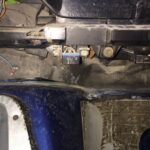Locating the OBD2 port in your 2002 Volkswagen Passat is the first step to diagnosing any potential issues with your vehicle. This port is your gateway to accessing the car’s computer system, allowing mechanics and DIY enthusiasts alike to read diagnostic trouble codes, check sensor data, and ensure your car is running smoothly. Knowing where this port is and understanding its power source is crucial for effective car maintenance.
Locating the OBD2 Port in Your 2002 Passat MKIV
For the 2002 Volkswagen Passat MKIV, the OBD2 port is typically found in a readily accessible location inside the cabin. You’ll want to look under the dashboard on the driver’s side. In most cases, it’s situated near the steering column or in the vicinity of the pedals.
While the location is generally consistent across MKIV Passat models, it’s always a good idea to double-check. Look for a trapezoid-shaped, 16-pin connector. It might be exposed or covered by a small plastic flap that is easily opened. If you’re having trouble spotting it immediately, try using a flashlight to illuminate the area under the dash and look for the distinctive shape of the OBD2 port.
Understanding the OBD2 Port Fuse (Fuse 12)
If you’re trying to use your OBD2 scanner and it’s not powering on when connected to your 2002 Passat, a common culprit is a blown fuse. In the MKIV Passat, Fuse 12 in the fuse box is specifically designated to power the Data Link Connector (DLC), which is another name for the OBD2 port.
The fuse box in a MKIV Passat is usually located on the driver’s side of the dashboard, often behind a panel that you can access from the side of the dash when the driver’s side door is open. Once you locate the fuse box, you’ll need to identify Fuse 12.
According to a typical MKIV Passat fuse diagram, Fuse 12 is a 7.5 amp fuse and is located in the top section of the fuse box layout. It’s always recommended to consult your owner’s manual for the precise fuse box diagram specific to your vehicle, as layouts can sometimes vary slightly.
If you suspect Fuse 12 is blown, here’s how to check and replace it:
- Locate the Fuse Box: Access the fuse box as described above.
- Identify Fuse 12: Refer to the fuse box diagram (usually inside the cover) to pinpoint Fuse 12. It’s often labeled or you can count positions based on the diagram.
- Inspect the Fuse: Carefully remove Fuse 12. You can use a fuse puller tool (often included in the fuse box) or needle-nose pliers. Hold the fuse up to the light and look at the thin wire inside. If the wire is broken or melted, the fuse is blown.
- Replace the Fuse: Use a new 7.5 amp fuse to replace the blown one. Ensure you are using the correct amperage. Never use a fuse with a higher amperage rating, as this can cause damage to your vehicle’s electrical system.
- Test Your OBD2 Scanner: After replacing the fuse, try connecting your OBD2 scanner again to see if it powers on and establishes a connection.
Here’s a snippet of the MKIV fuse list for reference, highlighting Fuse 12:
MKIV FUSE LIST (Top Section – Relevant Excerpt)
| Column | Fuse Number | Function | Amperage |
|---|---|---|---|
| … | 11 | Instrument cluster, shift lock solenoid | 5A |
| 12 | Data Link Connector (DLC) power supply (OBD2 Port) | 7.5A | |
| 13 | Brake tail lights | 10A | |
| … | … | … | … |
Note: While sometimes a fuse might appear visually intact, it can still be faulty. If you’re unsure, it’s always a good practice to replace Fuse 12 with a new 7.5 amp fuse to rule out a fuse issue.
Conclusion
Finding the OBD2 port and ensuring it’s properly powered is essential for diagnosing and maintaining your 2002 VW Passat. By knowing the port’s location under the driver’s side dashboard and understanding that Fuse 12 is responsible for its power supply, you can effectively troubleshoot common OBD2 connection problems. Remember to always use the correct fuse amperage and consult your owner’s manual for the most accurate information specific to your vehicle. This knowledge empowers you to take a proactive approach to your car’s health and communicate effectively with automotive professionals when needed.
